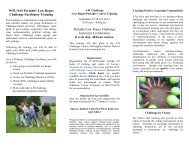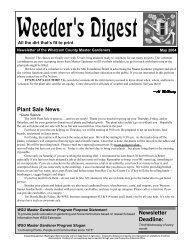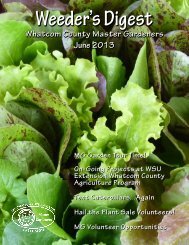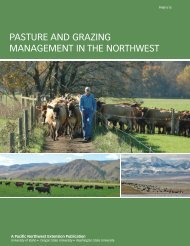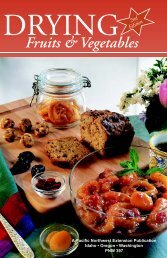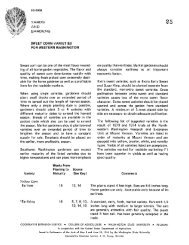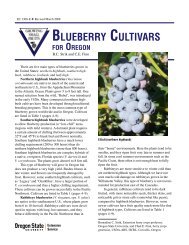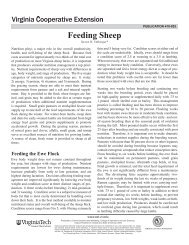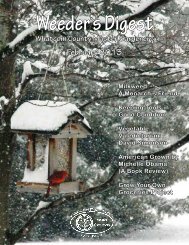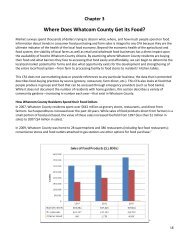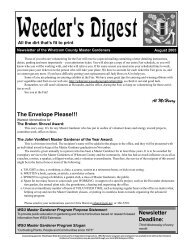May - WSU Whatcom County Extension - Washington State University
May - WSU Whatcom County Extension - Washington State University
May - WSU Whatcom County Extension - Washington State University
You also want an ePaper? Increase the reach of your titles
YUMPU automatically turns print PDFs into web optimized ePapers that Google loves.
Weeder’s Digest<br />
<strong>Whatcom</strong> <strong>County</strong> Master Gardeners<br />
<strong>May</strong> 2013<br />
Honeybee Swarms<br />
Hooray for Hoop<br />
Houses<br />
Susceptibility of<br />
Rhododendrons to<br />
P. ramorum<br />
Don’t Forget!<br />
Annual MG Plant Sale
From the<br />
Coordinator’s<br />
Desk...<br />
Hello Master Gardeners,<br />
I am so happy that all 22 class members are finishing up<br />
their course work. Many great projects and much energy<br />
are coming out of this class! We’re working to complete<br />
the course work and final exam successfully. I want to be<br />
sure that they are all welcomed into the Master Gardener<br />
community and the larger community as they embark on<br />
projects and volunteering. Special thanks to all those who<br />
helped with this year’s training!<br />
I had the opportunity to teach “All About Soils” at the<br />
Children’s Story Garden a couple weeks ago. It was such<br />
a fun group of preschoolers. I also taught a class out in<br />
Kendall with Alex Burrows, as well as a class with 4th and<br />
5th graders in Blaine with Jacqui MacConnell. Both Alex<br />
and Jacqui are students in this year’s Master Gardener<br />
class.<br />
I’m excited for the plant sale and am posting flyers all over<br />
town. (See the flyer attached to this newsletter.)<br />
Other upcoming events that the Master Gardeners are a<br />
part of include:<br />
• MGs at the Bellingham Farmer’s Market - <strong>May</strong> 4th and<br />
then every second Saturday throughout the season.<br />
• MGs at the Bellingham Library. I’m looking for<br />
volunteers to run a mini-clinic and maybe a miniworkshop<br />
in June.<br />
• MGs invited to be a part of the <strong>May</strong> 18th Flora Fair –<br />
Fairhaven. If you are interested, please let me know.<br />
Susan Anderson and Gloria Perez were at the opening<br />
day of the Ferndale Market representing the MGs with an<br />
information booth. Thanks ladies, sorry it was wet!<br />
Beth Chisholm<br />
<strong>Whatcom</strong> <strong>County</strong> Master Gardeners Program<br />
1000 N. Forest Street<br />
Suite 201<br />
Bellingham, WA 98225-5594<br />
360-676-6736<br />
http://whatcom.wsu.edu/mastergardener/<br />
MISSION: The <strong>WSU</strong> <strong>Extension</strong> Master Gardeners Program<br />
trains volunteers to be effective community educators in<br />
gardening and environmental stewardship.<br />
<strong>WSU</strong> WHATCOM COUNTY EXTENSION STAFF:<br />
Drew Betz: <strong>County</strong> Director<br />
Chris Benedict: Agriculture Educator<br />
Colleen Burrows: Agriculture Special Projects Coordinator<br />
Beth Chisholm: Master Gardeners & Community First<br />
Gardens Project<br />
Cheryl Kahle: Office Manager<br />
<strong>Whatcom</strong> <strong>County</strong> Master Gardener Foundation<br />
ROLE: The Master Gardener Foundation of <strong>Whatcom</strong> <strong>County</strong><br />
supports the MG program with fundraising and provides<br />
information about home horticulture to the public through a<br />
demonstration garden, lectures and home gardening advice.<br />
MG FOUNDATION BOARD:<br />
Past President: Loretta Hogg<br />
President: Sandy Keathley<br />
1st Vice President: Louise Granger<br />
2nd Vice President: Chris Hurst<br />
Secretary: Kay Reddell<br />
Treasurer: Pat Edwards<br />
Members at Large: Linda Battle & Kathleen Bander<br />
Representative to <strong>State</strong> Foundation: Linda Bergquist<br />
The Weeder’s Digest is the monthly newsletter of the<br />
<strong>Whatcom</strong> <strong>County</strong> Master Gardeners Program. Guest articles<br />
are encouraged. Please submit to Jo Fleming (jof@uw.edu).<br />
Articles are most appreciated if they contain 600 or fewer<br />
words and are accompanied by a photo. Editors reserve the<br />
right to edit for content and formatting.<br />
cooperating agencies: <strong>Washington</strong> <strong>State</strong> <strong>University</strong> and U.S.<br />
Department of Agriculture. <strong>Extension</strong> programs and employment are<br />
available to all without discrimination. Evidence of noncompliance<br />
may be reported through your local <strong>Extension</strong> Office.<br />
Cover photo - Trillium Ovation - by Teresa Rohwer, MG 2012
<strong>May</strong> 2<br />
Thursday<br />
<strong>May</strong> 4<br />
Saturday<br />
<strong>May</strong> 5<br />
Sunday<br />
<strong>May</strong> 9<br />
Thursday<br />
<strong>May</strong> 11<br />
Saturday<br />
<strong>May</strong> 18<br />
Saturday<br />
<strong>May</strong> 19<br />
Sunday<br />
<strong>May</strong> 23<br />
Thursday<br />
June 2<br />
Sunday<br />
MG Calendar - <strong>May</strong> 2013<br />
MG Foundation Board<br />
Meeting<br />
MGs at the Bellingham<br />
Farmer’s Market<br />
Preparing Your Soil<br />
MG Foundation General<br />
Meeting<br />
Master Gardener Plant<br />
Sale<br />
MGs at the Annual<br />
Backyard Habitat &<br />
Native Flora Fair<br />
Transplanting and<br />
Planting Properly<br />
<strong>May</strong> Monthly Plant<br />
Study Group<br />
Growing Vegetables in<br />
Small Spaces<br />
<strong>WSU</strong> <strong>Whatcom</strong> <strong>County</strong> <strong>Extension</strong> Office, 10:00am-12:00pm<br />
MGs will have a booth at the market every second Saturday throughout the<br />
season. Downtown, Depot Market Square, 1100 Railroad Avenue, Bellingham,<br />
10:00am to 3:00 pm.<br />
Tennant Lake Interpretive Center, 2:00pm. Kathy Harrison will discuss planning<br />
ahead before you plant.<br />
<strong>WSU</strong> <strong>Whatcom</strong> <strong>County</strong> <strong>Extension</strong> Office, 6:30pm. Honey Bees: the Colony &<br />
Some Aspects of Its Maintenance. Open to all Master Gardeners and the public.<br />
Hovander Homestead Park, 9:00am-2:00pm. For more information, please<br />
contact 360-676-6736 or visit: http://whatcom.wsu.edu/mastergardener/plant_<br />
sale.htm. Also see article in this newsletter.<br />
MGs are invited to be a part of the Flora Fair, Fairhaven Village Green, 10:00am-<br />
4:00pm. The fair features a native plant sale, a guided native plant walk, noxious<br />
weed information, and more.<br />
Hovander Homestead Park, 2:00pm. Beth Chisholm presents when and how to<br />
plant and transplant.<br />
Cordata Food Cooperative (upstairs meeting room), 9:00am-11:00am. Contact<br />
Karen Gilliam for more information, kgilliam@gmail.com.<br />
Hovander Homestead Park, 2:00pm. Janet Bieber presents how to raise your<br />
favorite vegetables and fruits in containers or small spaces.<br />
Community Events - <strong>May</strong> 2013<br />
Sustainable Bellingham<br />
www.sustainablebellingham.org/events/upcoming/<br />
<strong>May</strong> 18 • 1:00pm-3:00pm<br />
Introductory Plant Walks: Backyard Habitat Fair &<br />
Padden Lagoon Walk<br />
Meet at Fairhaven Village Green. Walk down the City<br />
Greenways trails around Padden Creek to view native<br />
plants.<br />
<strong>May</strong> 19 • 2:00pm-3:30pm<br />
Sprout Walk: A Family Plant Walk at Tennant Lake<br />
(Hovander Park)<br />
Designed for children 4-6 yrs old with adult guardians.<br />
Explore plants and discover shapes, textures, and colors.<br />
Meeting Point: Tennant Lake Interpretive Center.<br />
<strong>May</strong> 30 • 6:00pm-dusk<br />
Introductory Plant Walks: Downtown Plants<br />
An evening walk investigating native plants in the urban<br />
environment, led by anthropologist Allan Richardson.<br />
Meet at the Environmental Learning Center on West<br />
Holly St. at Maritime Heritage Park.<br />
Cloud Mountain Farm Center - 360.966.5859<br />
<strong>May</strong> 18 • 10:30am-noon<br />
Using Tunnels and Hoop Houses for Productive<br />
Gardening<br />
Grow great tomatoes and peppers in the Northwest.<br />
Learn house construction, planting, pruning, and<br />
management issues.<br />
Bakerview Nursery - 360.676.0400<br />
<strong>May</strong> 4 • 10:00am<br />
Kids’ Mother’s Day Workshop<br />
Kids will create a “one of a kind” gift for Mom by<br />
decorating a small pot and planting it with a flower.<br />
<strong>May</strong> 18 • 10:00am<br />
Growing Tomatoes in <strong>Whatcom</strong> <strong>County</strong><br />
An expert will share knowledge for successfully growing<br />
tomatoes in our challenging climate - learn staking,<br />
pruning, fertilizing and more.<br />
<strong>May</strong> 19 • 11:00am<br />
Hanging Moss Basket Demonstration<br />
Watch an expert assemble and plant a hanging moss<br />
basket. Learn container choices, plant selection, and<br />
long-term care.<br />
<strong>May</strong> 25 • 10:00am<br />
Blueberry Magic!<br />
Learn everything about successful blueberry raising in<br />
our region, and prepare for an abundant harvest.<br />
Other Happenings<br />
<strong>May</strong> 4<br />
Mothers Day Week at The Garden Spot<br />
<strong>May</strong> 4-5 • 9:00am-5:00pm (Sat), 9:00am-4:00pm (Sun)<br />
Annual Rare and Unusual Plant Sale<br />
1685 Grandview Place, Ferndale.
All the Latest MG<br />
& Foundation<br />
News!<br />
Master Gardener<br />
Foundation Notes<br />
What an exciting time of the year! The morning sun on<br />
the new tree leaves just glows, the birds are happy and our<br />
gardens are starting to take shape. On the other hand, the<br />
lawns need mowing now, the weeds are back, and here<br />
come the slugs! But it’s great to have our hands in the dirt<br />
and the sun on our backs again.<br />
Our annual plant sale will be here before we know it. So<br />
here’s my last-minute plea for plants - you can just dig them<br />
up, put labels on so we know what they are and leave them<br />
out at the old greenhouse in some soil (there’s some out<br />
there). We need them by Wednesday, <strong>May</strong> 8. If you need<br />
help, please contact us! We’ll pot them up for the sale and<br />
make any additional labels necessary. Also, we need boxes<br />
for the customers. The more boxes available - the more<br />
plants they can carry around and purchase. Let’s make this<br />
an amazing sale! Thanks!<br />
Sandy Keathley, MGF President<br />
MG Foundation<br />
<strong>May</strong> Meeting<br />
<strong>WSU</strong> <strong>Whatcom</strong> Master Gardener Foundation Meeting<br />
Thursday, <strong>May</strong> 9th, 2013 at 7:00 pm<br />
<strong>WSU</strong> <strong>Whatcom</strong> <strong>County</strong> Master Gardener Foundation<br />
Meeting will feature Guest Speaker Hubertus Kohn who<br />
will speak on: “Honey Bees: the Colony & Some Aspects<br />
of Its Maintenance.”<br />
Dr. Kohn studied at the <strong>University</strong> of Munich, <strong>University</strong><br />
of Innsbruck, <strong>University</strong> of Missouri, and then moved<br />
to Bellingham where he was a Professor of Biology at<br />
Western <strong>Washington</strong> <strong>University</strong> until retiring in 1999.<br />
He started working with honey bees in 1945, and during<br />
the last 8 years has specifically studied the methods of<br />
honey-bee queen rearing.<br />
The lecture will include honey bee biology, honey<br />
bee colony composition, function and maintenance,<br />
the importance of honey bee genetics, nutritional<br />
requirements, and some of the major honey bee<br />
diseases and pests. There will be pictures and some<br />
video clips.<br />
MGF invites the public, with social time at 6:30 pm,<br />
MGF Meeting at 7:00 pm, and the speaker to follow,<br />
at the <strong>WSU</strong> <strong>Whatcom</strong> <strong>County</strong> <strong>Extension</strong> Office, 1000<br />
North Forest Street, Bellingham.<br />
Volunteer Opportunities<br />
• Northwest Youth Services Garden “WE GROW” - Every Tuesday, 1:00 - 4:00pm, 1020 N. <strong>State</strong> St.,<br />
Bellingham - just one block from the <strong>WSU</strong> <strong>Extension</strong> Office. Help plan, prepare and plant the garden.<br />
Peas, potatoes, greens, and onions are in the ground. All produce will be sold at their market stand<br />
and to local restaurants throughout the season. These youth are trying to build social and job skills to<br />
improve their lives.<br />
• The Ferndale Food Bank Director would love to connect with more of the Master Gardener<br />
volunteers who grow food and flowers at Hovander!<br />
• MGs at the Bellingham Farmer’s Market - <strong>May</strong> 4th and then every second Saturday throughout the<br />
season.<br />
• MGs at the Bellingham Library - Beth is looking for volunteers to run a mini-clinic and maybe a miniworkshop<br />
in June.<br />
• Flora Fair – Fairhaven - MGs are invited to be a part of the <strong>May</strong> 18th fair. If you are interested, please<br />
let Beth know. beth.chisholm@wsu.edu • (360) 676-6736<br />
• Cloud Mountain Farm Center - Volunteer hours are available to Master Gardeners who would enjoy<br />
assisting in the nursery. Following are nursery tasks needing attention in the month <strong>May</strong>: sheering<br />
broadleaf evergreens and conifers, weeding, potting, watering and fertilization. Ideally, Master<br />
Gardeners interested in volunteering would be available to work for two to three hours on Mondays<br />
or Tuesdays for at least four consecutive weeks. For more information, call Lori Polevoi at 966-5859.
Honeybee<br />
Swarms<br />
by Mt. Baker<br />
Beekeepers Association<br />
Yes, the sun can still shine in <strong>Whatcom</strong> <strong>County</strong>! This has<br />
been a reasonably wet and mild winter. With the warmer<br />
“drier” weather, comes the fruit and berry blossoms<br />
along with the natural progression of life. Honeybee<br />
colonies reproduce and expand their numbers by a natural<br />
progression, called swarming.<br />
A healthy honeybee colony can contain as many as<br />
30,000+ bees. Of these, about 300 are male drones, and<br />
only one single queen. As the bee colony population<br />
continues to increase, the parent colony becomes overcrowded,<br />
forcing it to send out a swarm. A swarm contains<br />
about 50% of the worker bees, a few drones and the old,<br />
existing queen.<br />
Before swarming, the parent colony begins to raise a few<br />
new queen cells. The swarm will leave about two days<br />
before the virgin queen emerges. The swarm is looking<br />
for a place to establish a new colony. Gorging themselves<br />
with honey as the swarm leaves, it appears to be a wild<br />
unsynchronized mess, bees everywhere, not really flying<br />
in any type of formation. In reality they are following a<br />
predetermined plan and find a place to land, rest, and<br />
reorganize. This “resting time” cluster appears as a large<br />
clump of bees hanging on a tree, porch post, wall, or stop<br />
sign.<br />
Somewhere in this large clump of tightly clinging bees<br />
is the solo queen. A swarm may hang in this location<br />
anywhere from a few hours to as much as three days.<br />
When you look at a honeybee swarm, you see nothing<br />
but a bee cluster about the size and shape of a football.<br />
The cluster is bee colored (honey brown) and not the gray<br />
color of a paper wasp nest. Scout bees from this honeybee<br />
cluster leave to find a suitable new home. The scout bees<br />
return to the cluster and convince the swarm that the new<br />
home location is acceptable.<br />
Capturing a honeybee swarm at this time is easiest for the<br />
beekeeper and best for the property owner. Once the bees<br />
enter a structure or tree cavity, they become established<br />
and cannot be easily removed without some demolition.<br />
The sooner a swarm is captured, the less likely it would<br />
become established in an attic, the eaves of a home, a car,<br />
or any other place they may find suitable.<br />
Honeybee picture taken from<br />
Farm, Garden and Beyond website<br />
http://beewarre.com/tag/beekeeping/<br />
As <strong>Whatcom</strong> <strong>County</strong> Beekeepers, we are interested in<br />
capturing honeybee swarms. The above synopsis is a<br />
very brief overview of what actually goes on during a<br />
swarm. We all need to see that the honeybee population<br />
remains strong and that these valuable pollinators survive.<br />
Please go to Mt. Baker Beekeepers Association, http://<br />
www.mtbakerbeekeepers.org/ for more information<br />
on Honeybees, as well as the local beekeepers who are<br />
interested in capturing swarms.
Hooray for<br />
Hoop Houses<br />
by Kathleen Bander, MG 2013 2012<br />
What to do I needed more space to start seeds and grow<br />
our vegetables year-round. Anyone who’s grown heat loving<br />
veggies—tomatoes, melons, peppers, eggplant—know what<br />
a challenge it can be in our unpredictable summers. This<br />
coupled with the ever-increasing price of fresh vegetables<br />
has led me to want more space to grow veggies all year long.<br />
The greenhouse I once thought a good size seemed to have<br />
shrunk, and a larger-sized one just wasn’t in the budget. So<br />
now what<br />
There are several important issues to consider before you<br />
begin. First, how big will it be Bigger is better, as a larger<br />
hoop house heats up faster and cools down slower. Second,<br />
there’s wind. Yup, and for some of us, lots of it.<br />
Without secure ends and tie-downs, your hoop house might<br />
pull a “Dorothy & the Wizard” when a severe storm hits. And<br />
though gardeners in the Northwest are sometimes doubtful,<br />
summer’s heat does arrive at some point, and you’ll have to<br />
quickly think about venting your hoop house. It can get hot<br />
inside!<br />
Many gardeners are firm believers in both raised beds and drip<br />
systems. Both of these work very well in hoop houses. In fact,<br />
anchoring the tie-downs to the raised beds is a great way to<br />
add additional security. Overhead watering should be avoided<br />
as it can lead to diseases, and drip systems solve that problem.<br />
Fate seemed to have the answer. On the calendar was a<br />
Cloud Mountain Nursery workshop I had signed up for long<br />
before, but I hadn’t written down the subject matter. When<br />
I got there, I was delighted and astounded to find that the<br />
subject to be covered was—Season Extenders: Cold Frames,<br />
Greenhouses, and Hoop Houses. The timing couldn’t have<br />
been better!<br />
A real advantage to hoop houses is that they are tall enough to<br />
walk in, making it more enjoyable for all the work that will go<br />
on inside. They can be left up year-round. If built sturdily, they<br />
can withstand what nature throws at them, and will last for<br />
years. Advances in the materials, particularly the poly<br />
covering, will ensure many years of use. Polyethylene plastic<br />
comes in many grades. A 6-mil weight is recommended<br />
for sturdy hoop houses. If treated with a UV inhibitor, it is<br />
guaranteed for 3 years, but many people are still using hoop<br />
houses they built 10 years ago.<br />
The hoop house we built measures 10’ X 22’. Materials cost<br />
right in the neighborhood of $700.00. Compare that to the<br />
cost of a similarly-sized greenhouse, and you’ll think it a<br />
bargain.<br />
<strong>Washington</strong> <strong>State</strong> <strong>University</strong> has an instructive manual,<br />
Portable Hoop Houses, <strong>WSU</strong> <strong>Extension</strong> Manual EM015. You’ll<br />
find the information invaluable. http://cru.cahe.wsu.edu/<br />
CEPublications/em015/em015.pdf<br />
For materials, there are many suppliers, so try searching the<br />
web, to find what might work best for you.<br />
Hoop houses open up an expanded way of gardening in<br />
challenging temperatures. Think of all the money you’ll save<br />
by growing your own veggies in the fall and winter. It doesn’t<br />
take a carpenter, or the sale of your first-born. And I would be<br />
happy to show you my hoop house before you take the leap.<br />
Just email me, kbwm@camano.net.<br />
Another helpful resource for hoop houses from our Mt.<br />
Vernon station is http://mtvernon.wsu.edu/hightunnels/<br />
Content/cropTunnels.html.
Susceptibility of<br />
Rhododendrons<br />
to P. ramorum<br />
by Marianne Elliott & Gary Chastagner<br />
<strong>WSU</strong> Puyallup Research & <strong>Extension</strong> Center<br />
The genus Phytophthora contains some of the most<br />
devastating plant pathogens in the world, unparalleled<br />
to other classes of plant pathogens. The quarantine plant<br />
pathogen Phytophthora ramorum has caused significant<br />
damage to forests in California and the United Kingdom,<br />
and infested nursery stock is responsible for long distance<br />
spread of the disease. While its origin is unknown, P.<br />
ramorum is thought to be a new introduction to North<br />
America and Europe. Phythophthora species are projected<br />
to be a continuing issue for the nursery industry as a result<br />
of international plant trade when diverse plant species and<br />
their associated pests and pathogens are introduced.<br />
Rhododendrons are an important nursery crop in the<br />
Pacific Northwest (PNW) and have accounted for about<br />
90% of infected plants associated with P. ramorum<br />
positive nurseries in <strong>Washington</strong> since 2004. In the United<br />
Kingdom, the most important host associated with the<br />
spread of P. ramorum from urban gardens to nearby rural<br />
landscapes is R. ponticum. This rhododendron is an invasive<br />
shrub that has colonized much of the forested area in<br />
the UK. Rhododendrons purchased from nurseries are a<br />
possible means for transmitting P. ramorum into gardens,<br />
landscapes, and forested areas in the PNW. In 2010 the<br />
first instance of P. ramorum spreading from infected<br />
rhododendrons in a nursery to adjacent landscape plants<br />
was detected in <strong>Washington</strong>. There have been several<br />
cases of P. ramorum being found on plants purchased<br />
from an infested nursery during trace-forward surveys by<br />
the <strong>Washington</strong> <strong>State</strong> Department of Agriculture (WSDA).<br />
Identifying species and cultivars that show some resistance<br />
to this pathogen will be an important management tool for<br />
preventing its introduction and spread.<br />
Phytophthora diseases on rhododendron can manifest<br />
as root disease, causing wilting of the entire plant, and<br />
as foliar and shoot blight. Phytophthora ramorum is not<br />
known as a root disease on rhododendron, but causes<br />
leaf spot and shoot blight symptoms. However, it can<br />
colonize the root system without causing symptoms. This<br />
is a possible means of spreading the disease in the nursery<br />
trade.<br />
Many plant diseases are caused by fungi. Phytophthora<br />
is not a fungus but is known as a ‘water mold’ and is<br />
closely related to aquatic organisms such as brown algae<br />
and diatoms. However, Phytophthora and fungi have<br />
similar life cycles and growth habits such as a network<br />
of fibers called ‘mycelium’ and reproduction by spores.<br />
In fact, Phytophthora has several spore stages. Under<br />
wet conditions the mycelium produces structures<br />
called ‘sporangia’ which contain swimming spores<br />
called ‘zoospores’ that are released in water when the<br />
temperature fluctuates. These spores can detect a plant<br />
host, usually from chemicals released by roots, and can<br />
swim and attach themselves to the root, germinate, and<br />
infect the plant. On the surface of rhododendron foliage,<br />
the zoospores are released in a film of water and can<br />
infect through stomates. The sporangia are produced on<br />
infected foliage and can be spread throughout the plant by<br />
splashing, either from overhead irrigation or rain.<br />
http://journals.oregondigital.org/ForestPhytophthora/article/view/3036/2721
When soils dry out P. ramorum produces another spore<br />
stage called the ‘chlamydospore’. This spore has thick walls<br />
and can survive dry conditions. Under moist conditions the<br />
chlamydospores germinate, sometimes directly into<br />
sporangia, and new infections can occur. Chlamydospores<br />
are also produced in infected foliage, which is<br />
a long-term inoculum reservoir for the pathogen as these<br />
leaves decay and infest the underlying soil or potting mix.<br />
In this study, forty-two Rhododendron species and<br />
45 cultivars (including hybrids) were evaluated for<br />
susceptibility to foliar infection in an effort to identify the<br />
risk that certain Rhododendron species and cultivars pose<br />
in spreading this disease. Plants were identified for testing<br />
based on input from industry representatives, <strong>Washington</strong><br />
<strong>State</strong> Department of Agriculture (WSDA), and the<br />
Rhododendron Species Foundation. Foliage of plants was<br />
collected and inoculated with zoospores from an isolate of<br />
P. ramorum originally collected from a rhododendron at an<br />
Oregon nursery. Wounds were created on some leaves with<br />
a pin before inoculation. Frequency of infection and lesion<br />
area were evaluated for each plant.<br />
There was a great deal of variability among Rhododendron<br />
species and cultivars in their susceptibility to foliar infection<br />
and the severity of symptoms. Several species and cultivars<br />
could be considered resistant, with low incidence and<br />
severity of disease. In general, species and cultivars with<br />
indumentum on the lower leaf surface were the most<br />
resistant. Indumentum is a physical barrier that can<br />
prevent zoospore infection of the leaf surface. If the leaf is<br />
wounded, infection can occur but it will be more difficult<br />
in species having a thick, dense layer of indumentum. On<br />
leaves that were wounded, Rhododendrons having scales<br />
(lepidote) on the leaf surface tended to become infected<br />
less often than those without scales (elepidote), but there<br />
was no difference in unwounded treatments. This suggests<br />
that there is a possible chemical barrier to P. ramorum<br />
R. macrophyllum, the WA state flower, is moderately<br />
susceptible to P. ramorum infection.<br />
infection that is released by wounding for some species and<br />
cultivars that have scales. Some lepidote Rhododendron<br />
species have oil glands within their scales that contain<br />
volatile compounds as a deterrent to feeding by insects and<br />
these chemicals may inhibit pathogens such as P. ramorum<br />
as well.<br />
Some resistant Rhododendron species included R. keiskei, R.<br />
arboreum, and R. mallotum, and resistant cultivars included<br />
R. ‘Ken Janeck’ and R. ‘Purple Gem’. These would be good<br />
candidates for nursery production and possibly for future<br />
hybridizing material. Likewise, several species and cultivars<br />
that were very susceptible were identified. Susceptibility of<br />
parents and their hybrids or cultivars was similar in most of<br />
the plants that were tested.<br />
Further reading:<br />
Riedel, M., Werres, S., Elliott, E., McKeever, K., Shamoun,<br />
S.F. 2012. Histopathological investigations of the infection<br />
process and propagule development of Phytophthora<br />
ramorum on rhododendron leaves. Forest Phytophthoras<br />
2(1). doi: 10.5399/osu/fp.2.1.3036<br />
Sporangia and mycelium on the surface of Rhododendron<br />
‘Purple Splendour’ leaf. This cultivar was one of the most<br />
susceptible to infection by P. ramorum and is also at high risk<br />
for spreading the disease, as seen by the large amount of<br />
sporangia produced. Photo by K. McKeever, <strong>WSU</strong>.<br />
R. ‘Fantastica’ has large flowers and interesting foliage<br />
– and is moderately resistant to P. ramorum.
Don’t Forget!<br />
<strong>Whatcom</strong> <strong>County</strong> Master Gardener<br />
Foundation Annual Plant Sale<br />
Saturday, <strong>May</strong> 11<br />
Hovander Homestead Park<br />
5299 Nielsen Road, Ferndale<br />
9:00 AM - 2:00 PM<br />
From the Bellingham Herald<br />
Since this event is one day before Mother’s Day, it’s<br />
a fine time to pick out a plant or two for Mom or<br />
someone special. As a family-friendly event, kids<br />
can be entertained by visiting the Family Activity<br />
Table, the Children’s Story Garden, or farm<br />
animals nearby.<br />
Preparations for the sale began this year in February, with<br />
Master Gardeners contributing many specimens from their<br />
own gardens. Plants of special note include: hard-to-find and<br />
taste-tested tomato plants; veggie starts, lettuce bowls,<br />
along with perennials, trees, shrubs, and herbs. Veteran<br />
<strong>WSU</strong> <strong>Whatcom</strong> <strong>County</strong> <strong>Extension</strong> Master Gardeners will<br />
be available to answer any garden related questions.<br />
The public is invited to attend this special event sponsored<br />
by the Master Gardener Foundation of <strong>Whatcom</strong> <strong>County</strong> and<br />
<strong>Whatcom</strong> <strong>County</strong> Parks & Recreation. All the proceeds of this<br />
annual sale are used to support the <strong>WSU</strong> <strong>Whatcom</strong> <strong>County</strong><br />
Master Gardener Program. For more information, phone<br />
<strong>WSU</strong> <strong>Whatcom</strong> <strong>Extension</strong> at 360-676-6736. (Contributed by<br />
Kathleen Bander, MG 2012)<br />
From Cascadia Weekly (4.24.13)<br />
“Last year, the amount of tomatoes I<br />
harvested from my backyard garden was unprecedented....I<br />
believe the main reason the harvest was so successful is<br />
because, per usual, I purchased the bulk of my tomato<br />
starts at the annual Master Gardener Plant Sale...<br />
Return customers know to clear spaces in their cars and<br />
get there early to ensure they can nab a conveyance to<br />
haul their gardening goods in, but even if you show up<br />
later, rest assured there’ll be plenty to discover - whether<br />
it’s tomato starts, dahlia bulbs, trees, shrubs, shade-loving<br />
plants or a wheelbarrow full of hostas.” (Amy Kepferle)



